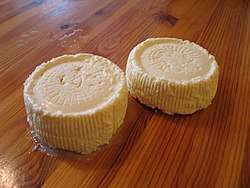Brocciu
Brocciu is a Corsican cheese produced from a combination of milk and whey, giving it some of the characteristics of whey cheese; it is produced from ewe's milk. It is notable as a substitute for lactose-rich Italian Ricotta, as brocciu contains less lactose.[1]
| Brocciu | |
|---|---|
 | |
| Country of origin | France |
| Region, town | Corsica |
| Source of milk | Sheep/Goat |
| Texture | Fresh/Soft |
| Aging time | Max. 1 month, usually none |
| Certification | French AOC 1983 |
Produced on the island of Corsica, brocciu is considered the island's most representative food. Like ricotta, it is a young white cheese and is paired frequently with Corsican white wines.
The word brocciu is related to the French word "brousse" and means fresh cheese made with goat or ewe's milk.
Brocciu is made from whey and milk. First, the whey is heated to a low temperature of just a few degrees below 100 °F (38 °C) and then ewe's milk is added and further heated to just a bit below 200 °F (93 °C). After heating, the cheese is drained in rush baskets.
The cheese is ready for consumption immediately, although it may be ripened for a few weeks (Corsican: brocciu passu or brocciu vechju); the ideal affinage time for Brocciu is 48 hours to one month.[2]
In the Corsican cuisine it is used in the preparation of innumerable dishes, from first courses to desserts.[3]
Notes
- "Delicious Corsica: Sampling the best of Corsican cuisine". National Geographic. 8 April 2019.
- "Brocciu Cheese-France: French Cheese Guide".
- Schapira 1994, p. 14.
References
- Schapira, Christiane (1994). La bonne cuisine corse (in French). Paris: Solar. ISBN 2263001778.CS1 maint: ref=harv (link)
- Juliet Harbutt, World Cheese Book, p. 43.